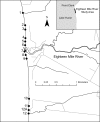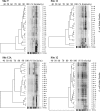Genetic relatedness of Escherichia coli isolates in interstitial water from a Lake Huron (Canada) beach
- PMID: 17261522
- PMCID: PMC1828823
- DOI: 10.1128/AEM.02437-06
Genetic relatedness of Escherichia coli isolates in interstitial water from a Lake Huron (Canada) beach
Abstract
Research was undertaken to characterize Escherichia coli isolates in interstitial water samples of a sandy beach on the southeastern shore of Lake Huron, Ontario, Canada. A survey of the beach area revealed the highest abundance of E. coli in interstitial water of the foreshore beach sand next to the swash zone. Higher concentrations of E. coli (up to 1.6 x 10(6) CFU/100 ml of water) were observed in the interstitial water from the sampling holes on the beach itself compared to lake water and sediment. Repetitive extragenic palindromic PCR (REP-PCR) was used to characterize the genetic diversity of E. coli isolates from interstitial water samples on the beach. E. coli isolates from the same sampling location frequently exhibited the same REP-PCR pattern or were highly similar to each other. In contrast, E. coli isolates from different sampling locations represented populations distinct from each other. This study has identified a unique ecological niche within the foreshore area of the beach where E. coli may survive and possibly multiply outside of host organisms. The results are of interest as increasing concentrations of E. coli in recreational waters are often considered to be an indication of recent fecal pollution.
Figures



Similar articles
-
Repetitive element (REP)-polymerase chain reaction (PCR) analysis of Escherichia coli isolates from recreational waters of southeastern Lake Huron.Can J Microbiol. 2009 Mar;55(3):269-76. doi: 10.1139/w08-123. Can J Microbiol. 2009. PMID: 19370070
-
Microarray analysis of Escherichia coli strains from interstitial beach waters of Lake Huron (Canada).Appl Environ Microbiol. 2007 Dec;73(23):7757-8. doi: 10.1128/AEM.01333-07. Epub 2007 Sep 21. Appl Environ Microbiol. 2007. PMID: 17890330 Free PMC article.
-
Multiple lines of evidence to identify the sources of fecal pollution at a freshwater beach in Hamilton Harbour, Lake Ontario.Water Res. 2007 Aug;41(16):3585-94. doi: 10.1016/j.watres.2007.05.012. Epub 2007 May 17. Water Res. 2007. PMID: 17575998
-
Distribution and diversity of Escherichia coli populations in the South Nation River drainage basin, eastern Ontario, Canada.Appl Environ Microbiol. 2010 Mar;76(5):1486-96. doi: 10.1128/AEM.02288-09. Epub 2009 Dec 28. Appl Environ Microbiol. 2010. PMID: 20038693 Free PMC article.
-
Population structure of Cladophora-borne Escherichia coli in nearshore water of Lake Michigan.Water Res. 2007 Aug;41(16):3649-54. doi: 10.1016/j.watres.2007.03.009. Epub 2007 Apr 23. Water Res. 2007. PMID: 17451778
Cited by
-
Impact of UV and peracetic acid disinfection on the prevalence of virulence and antimicrobial resistance genes in uropathogenic Escherichia coli in wastewater effluents.Appl Environ Microbiol. 2014 Jun;80(12):3656-66. doi: 10.1128/AEM.00418-14. Appl Environ Microbiol. 2014. PMID: 24727265 Free PMC article.
-
Diverse and abundant multi-drug resistant E. coli in Matang mangrove estuaries, Malaysia.Front Microbiol. 2015 Sep 29;6:977. doi: 10.3389/fmicb.2015.00977. eCollection 2015. Front Microbiol. 2015. PMID: 26483759 Free PMC article.
-
Pathogenic potential, genetic diversity, and population structure of Escherichia coli strains isolated from a forest-dominated watershed (Comox Lake) in British Columbia, Canada.Appl Environ Microbiol. 2015 Mar;81(5):1788-98. doi: 10.1128/AEM.03738-14. Epub 2014 Dec 29. Appl Environ Microbiol. 2015. PMID: 25548059 Free PMC article.
-
Change in the Structure of Escherichia coli Population and the Pattern of Virulence Genes along a Rural Aquatic Continuum.Front Microbiol. 2017 Apr 18;8:609. doi: 10.3389/fmicb.2017.00609. eCollection 2017. Front Microbiol. 2017. PMID: 28458656 Free PMC article.
-
Microbes in Beach Sands: Integrating Environment, Ecology and Public Health.Rev Environ Sci Biotechnol. 2014 Sep 1;13(3):329-368. doi: 10.1007/s11157-014-9340-8. Rev Environ Sci Biotechnol. 2014. PMID: 25383070 Free PMC article.
References
-
- Alm, E. W., J. Burke, and E. Hagan. 2006. Persistence and potential growth of the fecal indicator bacteria, Escherichia coli, in shoreline sand at Lake Huron. J. Great Lakes Res. 32:401-405.
-
- Alm, E. W., J. Burke, and A. Spain. 2003. Fecal indicator bacteria are abundant in wet sand at freshwater beaches. Water Res. 37:2978-2982. - PubMed
-
- Byappanahalli, M. N., and R. S. Fujioka. 1998. Evidence that tropical soil environment can support the growth of Escherichia coli. Water Sci. Technol. 38:171-174.
Publication types
MeSH terms
Substances
LinkOut - more resources
Full Text Sources

